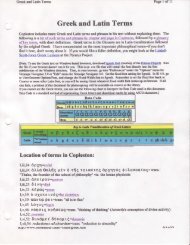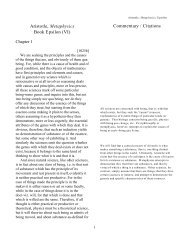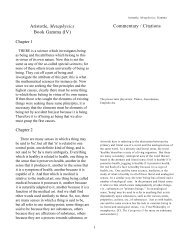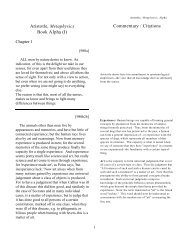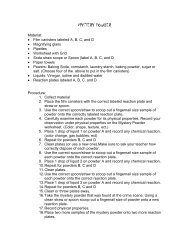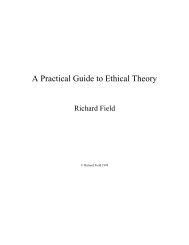Aristotle, Metaphysics Book Zeta (VII) Commentary ... - CATpages
Aristotle, Metaphysics Book Zeta (VII) Commentary ... - CATpages
Aristotle, Metaphysics Book Zeta (VII) Commentary ... - CATpages
You also want an ePaper? Increase the reach of your titles
YUMPU automatically turns print PDFs into web optimized ePapers that Google loves.
<strong>Aristotle</strong>, <strong>Metaphysics</strong>, <strong>Zeta</strong><br />
way. Therefore these materials are principles and<br />
parts of the concrete things, while of the form<br />
they are neither parts nor principles. And<br />
therefore the clay statue is resolved into clay and<br />
the ball into bronze and Callias into flesh and<br />
bones, and again the circle into its segments; for<br />
there is a sense of 'circle' in which involves<br />
matter. For 'circle' is used ambiguously, meaning<br />
both the circle, unqualified, and the individual<br />
circle, because there is no name peculiar to the<br />
individuals.<br />
The truth has indeed now been stated, but still<br />
let us state it yet more clearly, taking up the<br />
question again. The parts of the formula, into<br />
which the formula is divided, are prior to it,<br />
either all or some of them. The formula of the<br />
right angle, however, does not include the<br />
formula of the acute, but the formula of the acute<br />
includes that of the right angle; for he who<br />
defines the acute uses the right angle; for the<br />
acute is 'less than a right angle'. The circle and<br />
the semicircle also are in a like relation; for the<br />
semicircle is defined by the circle; and so is the<br />
finger by the whole body, for a finger is 'such and<br />
such a part of a man'. Therefore the parts which<br />
are of the nature of matter, and into which as its<br />
matter a thing is divided, are posterior; but those<br />
which are of the nature of parts of the formula,<br />
and of the substance according to its formula, are<br />
prior, either all or some of them. And since the<br />
soul of animals (for this is the substance of a<br />
living being) is their substance according to the<br />
formula, i.e. the form and the essence of a body<br />
of a certain kind (at least we shall define each<br />
part, if we define it well, not without reference to<br />
its function, and this cannot belong to it without<br />
perception), so that the parts of soul are prior,<br />
either all or some of them, to the concrete<br />
'animal', and so too with each individual animal;<br />
and the body and parts are posterior to this, the<br />
essential substance, and it is not the substance<br />
but the concrete thing that is divided into these<br />
parts as its matter:--this being so, to the concrete<br />
thing these are in a sense prior, but in a sense<br />
they are not. For they cannot even exist if<br />
The main point here is, as <strong>Aristotle</strong> says, that the question<br />
of whether a substance is prior or posterior to its parts is<br />
not a simple one, for it depends on how one conceives the<br />
whole and parts. If we ask whether the hum an being is<br />
prior or posterior to its parts--that is, its human parts--then<br />
the parts are posterior, since reference to the human being<br />
includes reference to the form of the human, and this form<br />
17



